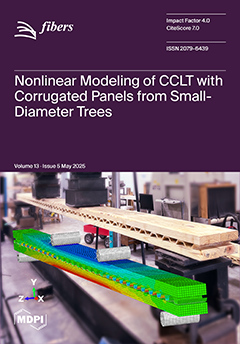Fused deposition modeling (FDM) 3D printing (3DP) of PLA biocomposites reinforced with plant-derived cellulosic fibrous materials, including spun yarn, microcrystalline, microfibrillar, nanofibrillar cellulose, and cellulose nanocrystals, offers an environmentally sustainable solution to the mechanical limitations of polymer-only printed materials. Micron- and submicron-scale cellulosic
[...] Read more.
Fused deposition modeling (FDM) 3D printing (3DP) of PLA biocomposites reinforced with plant-derived cellulosic fibrous materials, including spun yarn, microcrystalline, microfibrillar, nanofibrillar cellulose, and cellulose nanocrystals, offers an environmentally sustainable solution to the mechanical limitations of polymer-only printed materials. Micron- and submicron-scale cellulosic fibers are valued for their renewability, non-toxicity, high surface area, and favorable elastic and specific moduli; notably, micron-scale reinforcements are particularly attractive due to their ease of large-scale industrial production and commercial viability. Similarly, PLA benefits from large-scale production, contributes to CO
2 sequestration through its raw material precursors, and requires less energy for production than non-biodegradable petroleum-derived polymers. Incorporating these raw materials, each of which offers attractive performance properties, complementary commercial strengths, and environmental benefits, as constituent phases in FDM 3D-printed biocomposites (FDMPBs) can further enhance the environmental responsiveness of an already low-waste FDM 3DP technology. Inspired by these compelling advantages, this paper critically reviews research on FDMPB with cellulosic reinforcements in a PLA matrix, uniquely categorizing studies based on the form of cellulosic reinforcement and its impact on the biocomposite’s structure and mechanical performance. Additionally, the review covers biocomposite filament production methods and the equipment involved, presenting an alternative framework for cataloging FDMPB research. A comprehensive literature analysis reveals that the wide variation in feedstocks, fiber–matrix compounding methods, equipment, and processing parameters used in filament production and 3DP complicates the comparison of FDMPB mechanical properties across studies, often resulting in conflicting outcomes. Key processing parameters have been compiled to bridge this gap and offer a more nuanced understanding of the cause-and-effect relationships governing biocomposite properties. Finally, targeted recommendations for future research on developing FDMPB with a PLA matrix and micron-scale cellulosic reinforcements are provided, addressing the knowledge gaps and challenges highlighted in the peer-reviewed literature.
Full article





